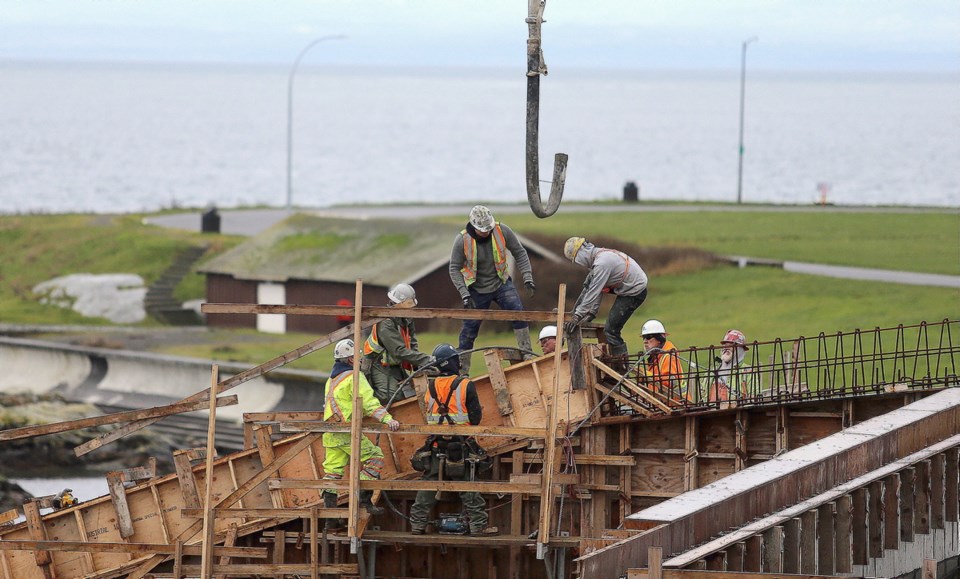The Tsartlip and Tsawout First Nations say they were not consulted by the Capital Regional District about its plans to ease a ban on the land application of treated sewage sludge so that some of the material can be used at the Hartland Landfill.
Tsartlip Chief Don Tom says he learned about the CRD’s decision from the media and warns that it sets a “dangerous precedent” for governments to take such steps without properly consulting First Nations and other nearby residents.
Tom and Tsawout Chief Nick Claxton both said Thursday that they support a call by Mike Hicks, regional director for the Juan de Fuca Electoral Area, asking that Environment Minister George Heyman give the CRD more time to properly consult and come up with a better solution for the biosolids.
“I think it would provide an opportunity to do what they should have done in the first place,” said Tom, who also sits on the executive of the WSANEC Leadership Council with Claxton and Chief Tanya Jimmy of the Tseycum First Nation.
Jimmy could not be reached for comment Thursday.
The Tsartlip and Tsawout join a growing number of people voicing concerns about the CRD’s decision to ease the nine-year-old ban.
Willis Point residents, who live near the landfill, have launched an online petition, fearing that contaminants in the biosolids will leach into their wells or get blown around the countryside.
The CRD banned the land application of biosolids in 2011 due to concerns that metals, pharmaceuticals and other materials in the sludge would harm farmland and food production. CRD directors upheld the ban again in 2013.
But with the region’s new wastewater treatment plant expected to come on line this year, the district has to find a way to deal with about 7,000 tonnes a year of dried biosolids that will be produced.
The plan at this point is to ship most of that granular material to the Lower Mainland, where it will be used as fuel in cement kilns. Those kilns, however, shut down for about four to six weeks a year, so the district has to dispose of about 700 tonnes of biosolids produced during those periods.
Initially, the district planned to simply dump it in the landfill, but Heyman directed the CRD to find a beneficial use for the material and submit a plan to him by the end of April.
So district staff recommended, and the board approved, using the material at the landfill to fertilize trees on closed sections of the dump or mixing it with other organic material to cover active sections and reduce greenhouse gas emissions by converting methane gas to carbon dioxide.
CRD spokesman Andy Orr said the district met with the WSANEC technical advisory committee in 2019 and reviewed the short-term beneficial-use plan that will be followed for five years. “The CRD agreed to meet again if there were changes to that plan,” he said in a statement.
“Since that time, the [environment] ministry has required a change to the contingency plan to be used for the one month a year that cement plants will be shut down, and the CRD is looking to meet with the WSANEC technical advisory committee at the earliest opportunity.”
Colin Plant, who chairs the CRD board, has said that he and a majority of board members were convinced that spreading biosolids at the Hartland Landfill for a short period of time poses no health hazard.
He said this week that the treatment process will render any contaminants in the biosolids inert and produce a product that exceeds provincial requirements.
Heyman’s ministry supports the land application of biosolids at Hartland as well, noting that it will “support vegetation re-growth and reduce greenhouse gas emissions.”
The ministry says that the use of biosolids is strictly controlled to protect human health and the environment.
Under the Organic Matter Recycling Regulation, biosolids “are treated and stabilized to reduce odours and harmful substances,” the ministry said in a statement. “Biosolids are then sampled by the wastewater treatment plant to ensure they meet the strict standards that are protective of human health and the environment.”
The ministry statement noted that the CRD has had three years to develop a biosolids management plan, and the province has no plans to give the district any more time.



